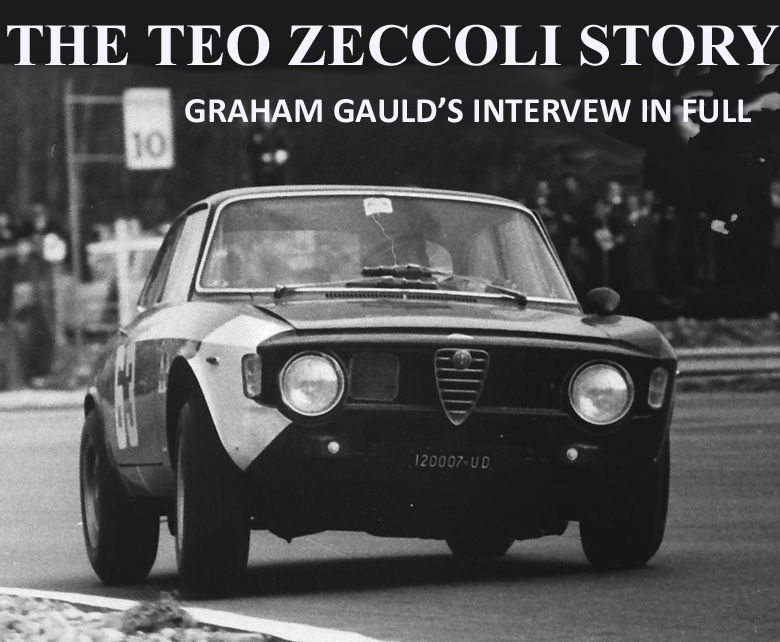
Zeccoli flat out at Spa in the Alfa Romeo GTA (Photo credit Centro Documentazione Alfa Romeo, Arese, Zeccoli Archives)
Teo Zeccoli passed away last week and it seemed fitting that we should republish Graham Gauld’s wonderful interview with Zeccoli in 2001, first published in VeloceToday.com on January 24 2013.
Story by Graham Gauld
In the alphabet of the world’s racing drivers, Teodoro Zeccoli comes somewhere near the end. He is a driver we have all heard about, due to his particular exploits with Alfa Romeo, but he is more than just a young Italian who grew up wanting to be a racing driver; Zeccoli was one of the favored test drivers of Carlo Chiti. Apart from being one of Chiti’s principals at Autodelta he was also the test driver for Chiti’s Formula 1 bad-egg, the ATS.
Zeccoli was one of a group of young Italian hotshoes who came to light in the 1960s that included Spartaco Dini, Ignacio Giunti, Roberto Bussinello and Nanni Galli.
I met up with him about ten years ago at his svelte BMW dealership in Imola, within earshot of the Enzo and Dino Ferrari Circuit. Though in his seventies, the tall and elegant Zeccoli was at first perplexed that anyone should want to know about his racing, but it was clear his racing years were dear to him.
The back wall of his dealership had an array of trophies, photographs and certificates highlighting his racing career. There were diplomas from the Automobile Club of Milan naming him Italian 1600cc Sports Car Champion in 1966 (Abarth), Touring Car Champion in 1970 (Alfa Romeo) and Sports Car Champion in 1971 (Alfa Romeo) and photographs of him racing all over the world.
Born in 1929 in Lugo, near Imola, Zeccoli did not fancy joining his father in the family business – which was making saddles for motorcycles – but had a passion for racing. His first race car was a Zagato-bodied Ermini Fiat 1100TV that he ran successfully in hill climbs and races during 1957. Later he had a Fiat 8V Zagato which he bought second-hand from a local Fiat dealer, and such was his success in events that he was approached by Sig. Dei of Scuderia Centro Sud to drive an OSCA MT4 in the Grand Prix of Liberation in Havana, Cuba. This race was put on by Castro to celebrate the overthrow of the Cuban government. Zeccoli finished 9th in the class driving a three-year-old Tipo S 1500 version of the OSCA MT4 (Chassis 1179).
Chassis 1179 had originally been a factory car raced by Giulio Cabianca, the late Colin Davis and the great Lodovico Scarfiotti, who had bought it from the factory to race as a private owner. By 1960, though entered by Centro Sud, the car was actually owned by Gianni Brichetti.
Brichetti also owned an 1100cc MT4 (Chassis 1144). Zeccoli drove this car in Italian events including the Shell meeting at Vallelunga on May 22, the Trento-Bondone hill climb on July 10th where he placed 5th in class, and he placed 4th in class at the Trofeo Val D’Intelvi on June 12 with the faster Tipo S. Zeccoli entered four more events with the Tipo S and was getting noticed. He only raced in 1960 with the OSCAs before being recruited by Abarth for their factory team and this led to his Italian Championship in 1961.
Originally Zeccoli was approached by Enzo Ferrari, but nothing came of it. He signed for Abarth instead, which had a heavy program of events, particularly hill climbs, which he enjoyed. In May that year he was paired with German driver Herbert Linge in a Fiat Abarth 1000 and finished second in his class just behind class winners Giancarlo Rigamonti and Jean Guichet in another Abarth 1000. Zeccoli spent two years as a factory driver with Abarth.
Luciano Greggio in Abarth, The man, the machines lists the following class victories for Zeccoli:
1961
August 6 Sestriere Hillclimb, 850 TC Abarth, first in 850 class
October 24 Montlhery, France 1000km Paris GT 1000cc class, Fiat Abarth Bialbero 1000
1962
April 15 Digne, France, Touring 850 cc, Fiat Abarth 850TC
May 13 Avusring, Germany, GT class, 700cc Fiat Abarth700 BA
May 20 Villefranche-sur-Saone Touring 850cc Fiat Abarth 850TC
ATS Test Driver
Around this time Carlo Chiti approached Teodoro Zeccoli to be test driver for both the ATS Grand Prix car and the GT. While Zeccoli was busy racing Abarths, Chiti was involved in the famous palace revolt at Ferrari, when a number of the key people were dismissed by Enzo Ferrari. Two of them were engineer/designer Chiti and team manager Romolo Tavoni. Another was Gerolamo Gardini, the Commercial Manager. He set about trying to find jobs for everyone, and approached a trio of industrialists led by Count Volpi, Giorgio Billi and Bolivian tin millionaire Jamie Ortiz Patino with a plan to design and build not only a GT car but a Grand Prix car for 1963.
There were many hurdles on the way to actually producing these cars. For example, Billi held the majority of shares, but Volpi wanted the cars to be called Serenissimas after his own team. There were a lot of wrangles which ended with Volpi withdrawing from the group almost before they had started. The company was then Automobili Turismo Sport or ATS, and work started on an ambitious factory on the outskirts of Bologna. At one early stage Billi was approached by Alfa Romeo for ATS to take over Alfa Romeo’s motor sport program, but Billi wanted to go it alone.
Despite the problems, for Chiti it all sounded too good to be true and he immediately got down to the task with his usual boundless enthusiasm, even though he was working out of a temporary cabin in the yard. In 1963 the ATS GT car was displayed at the Geneva Motor Show and the Grand Prix car the same month at Monza.
The problem of who was to drive the Grand Prix car was made simple. Enzo Ferrari had fired all his drivers. Chiti approached Phil Hill and Giancarlo Baghetti to be the factory ATS drivers. However, the whole affair was a bit of a disaster.
Zeccoli has little to say about it all. He actually did very little testing of the Grand Prix car but helped persuade Billi that a lightweight version of the 2500cc GT car might do well. Two of them turned up at the Targa Florio that year, one driven by Piero Frescobaldi and Giancarlo Baghetti and the other by Zeccoli and Paolo Gardi, but neither car finished. Later that season, one of the cars was loaned to ex-Stirling Moss mechanic Alf Francis, who entered it for the Reims 12 hour race with Zeccoli and the Portuguese driver Mario Cabral. The team was involved in a road accident and the car did not start. It was its last appearance as an ATS.
All that Zeccoli will say about the ATS was that the car had promise but the aluminium cylinder block was always very fragile and the budget was such that there were always little problems with it.
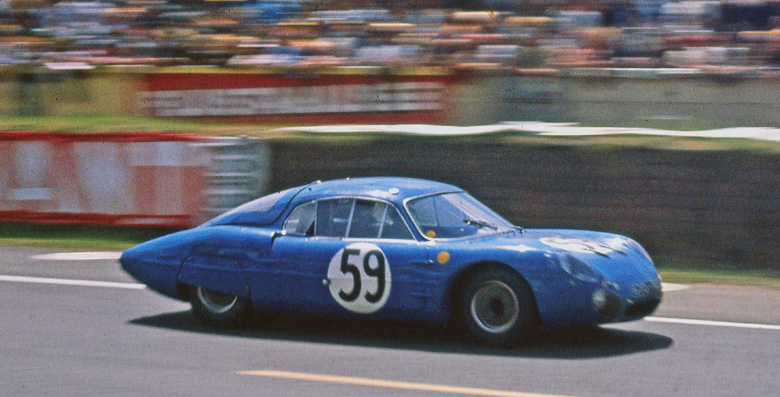
The Zeccoli/Masson M64 Alpine at Le Mans in 1964. The team would finish a credible 20th overall, fifth on the Index of Performance after suffering ignition problems. Photo CD courtesy Roy Smith.
In 1964 Zeccoli raced at Le Mans with Roger Masson in his Renault Alpine and did a few races in Alpines. He would soon be back with Chiti and another adventure, this one being much more successful.
ATS was a recipe for disaster. It didn’t take Carlo Chiti long before he had enough. He joined forces with his friend Ludovico Chizzola in his Autosport Company, which prepared touring cars for racing. The company they formed together was Delta Auto, later changed to Autodelta. Chiti recalled the previous approach to ATS from Alfa Romeo and so contacted Giuseppe Luraghi, the Chairman of Alfa Romeo, and was offered the chance to take on the program. Chiti then resigned from ATS and took Teodoro Zeccoli with him as test driver. Zeccoli’s career took another step forward.
The Autodelta years
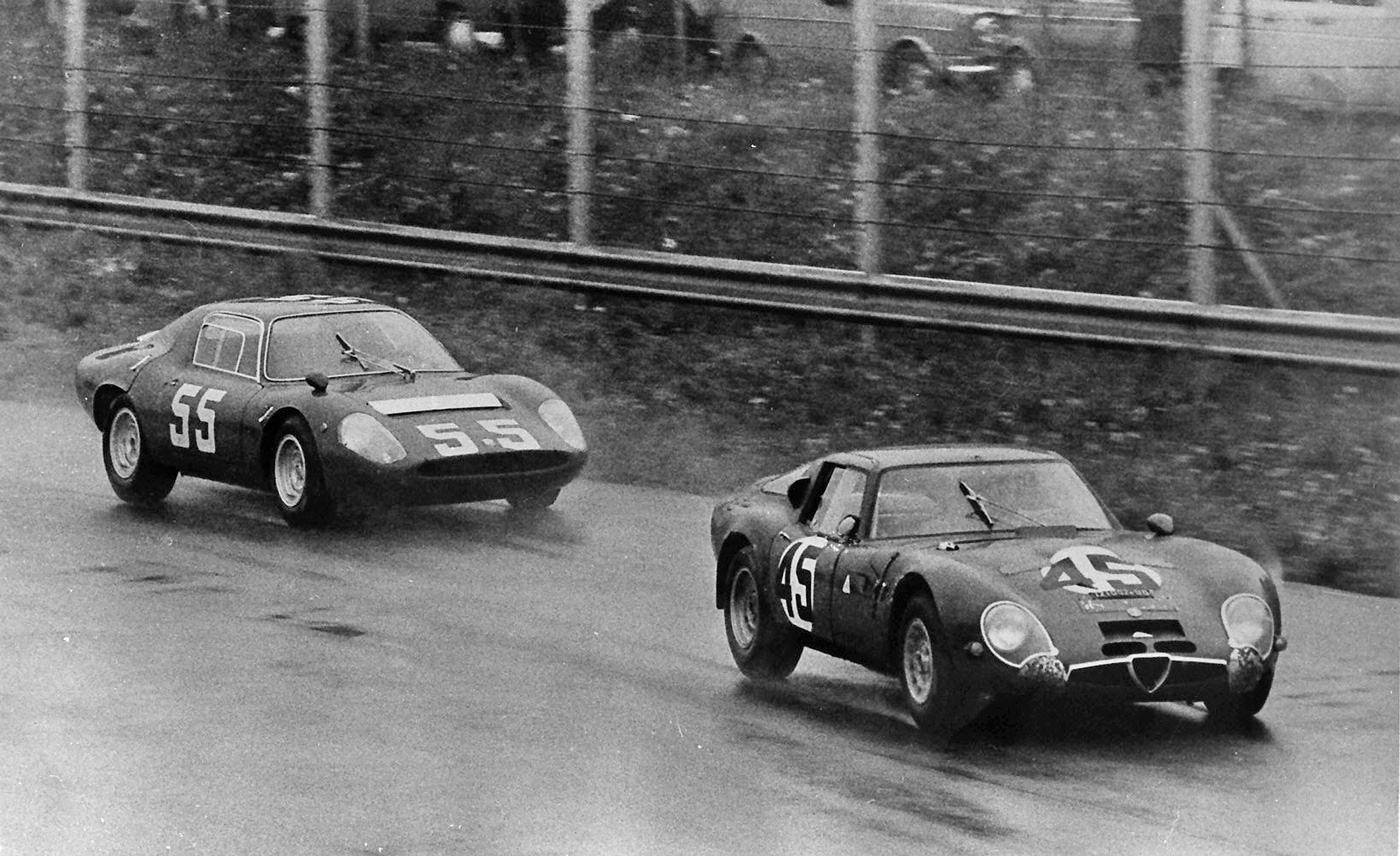
Racing in the wet with the Alfa Romeo TZ 2 at Monza in 1966. Teodoro Zeccoli brakes for the Parabolica. He would win his class with co-driver De Adamich. (Photo credit Centro Documentazione Alfa Romeo, Arese, Zeccoli Archives)
Autodelta were initially engaged to develop and build the Alfa TZ1 and 2. As the Autodelta company operated out of premises in Udine, it was very inconvenient and eventually Alfa asked them to transfer to Milan to be closer to the factory. They found a place at Settimo Milanese to the north of the city, but not long afterwards Alfa realized that Autodelta was getting just a bit too big. Autodelta was then absorbed into the Alfa Romeo group with Chiti running everything independently.
All of the testing for Alfa Romeos was conducted at the specially-built circuit complex at Balocco outside Milan. It is a huge facility, covering two million square meters, built on farm land originally used for the production of rice, which is common around that part of Italy. It was officially opened in 1963, the same year Autodelta was founded, and the farmhouse was retained and refurbished to give a place where the drivers could relax during long distance testing and where visitors could be brought to see the action.
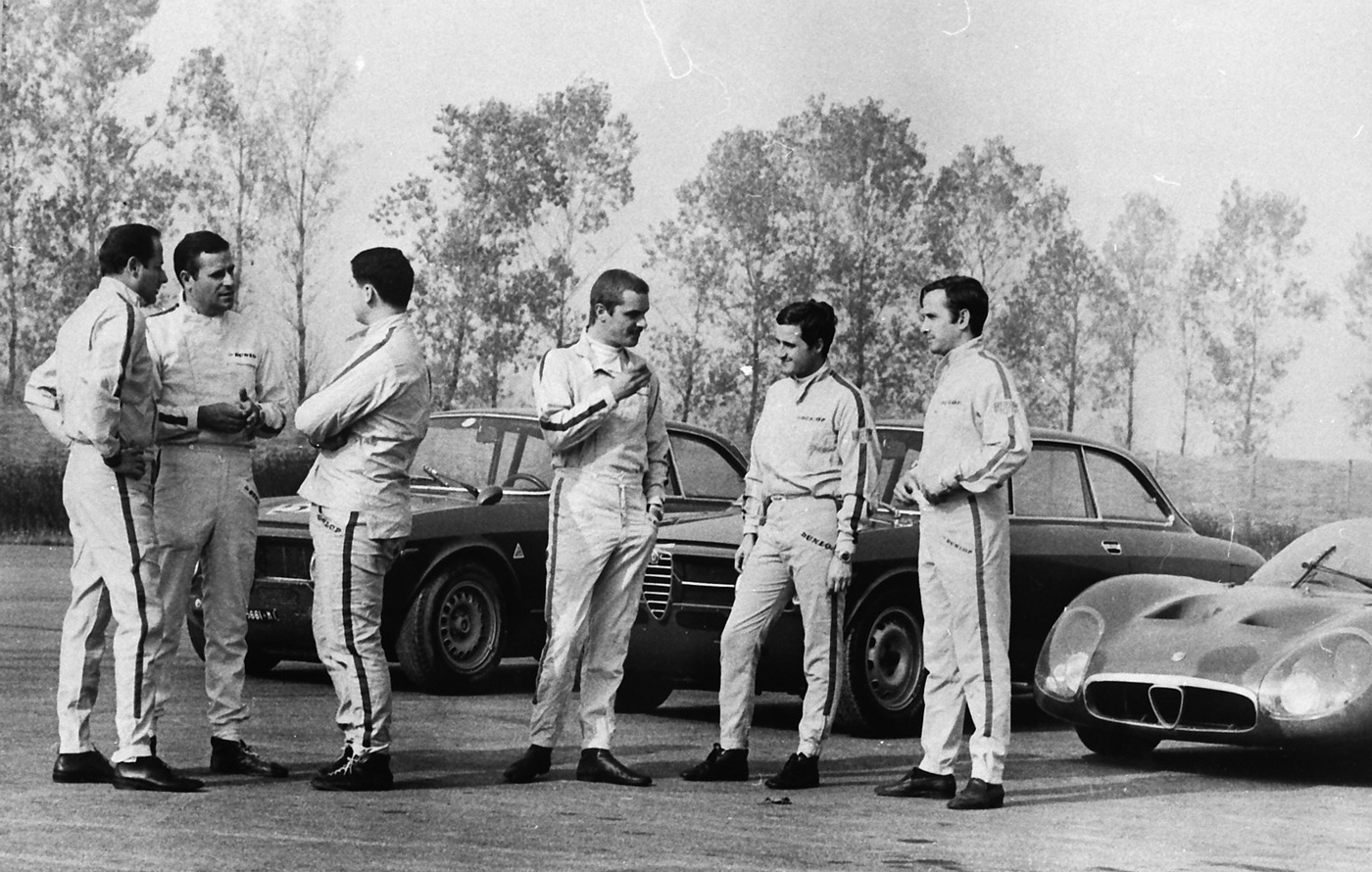
The Italian young bloods of the 1960\’s photographed at Balocco. Left to right Roberto Bussinello, Teodoro Zeccoli, Enrico Pinto, Spartaco Dini, Nanni Galli and Ignazio Giunti. (Photo credit Centro Documentazione Alfa Romeo, Arese, Zeccoli Archives)
At one time there were six official Alfa Romeo test drivers, all under the guidance of the legendary Alfa Romeo tester Consalvo Sanesi. Of those six, Teodoro Zeccoli had special responsibilities solely to Autodelta, so he was the main test driver of the racing cars. He was occasionally brought into the road car development programs when they felt they needed his expertise, but normally that was left to the other five test drivers of the day: Bruno Bonini, Guido Moroni, Carlo Galfan, Mario de Guiseppe and Ernesto Pagnacco.
Testing the Tipo 33 Alfas
Throughout this period, Zeccoli was usually kept busy on the testing and racing program. But in addition to his driving for Alfa, he raced a Ferrari 250LM for Luigi Chinetti at Le Mans in 1969 and finished 8th overall, sharing the car (5893) with American Sam Posey. Five years later, in 1974, he was again invited to race for NART with Jean-Claude Andruet in Luigi Chinetti’s “American” Ferrari 312P finishing 9th overall.
Zeccoli raced almost every Alfa Romeo from the 1960’s until he retired in 1981. As we sat with him in his office, he riffled through piles of photographs of testing at Balocco and constantly referred to his diaries. It is quite remarkable that each year he bought an identical A5 diary and every day wrote short notes of his testing. You could pick up any of the years, open at a page and find what he did that day. In one of them was a terse remark that he had hit close to 200 mph at Balocco in the Tipo 33-3 12 cylinder, the first time he had reached this figure when testing.
When Autodelta was given the go-ahead to develop the Alfa Romeo 33-2, it was Teodoro Zeccoli who raced it for the first time. Alfa chose a relatively unknown hill climb at Fleron in Belgium for the debut, and Zeccoli won the event outright. Though he was not always a member of the factory team of 33-2 drivers, he raced for the factory at circuits such as Mugello. He worked behind the scenes on the development of the Alfa Giulia GTA and later the 2 litre GTAM, but was mainly kept busy throughout the 1970’s with the Type 33 in all its guises. He has fond memories of the SC Turbo, and his last official race was at the wheel of one of the Fernet Branca cars with Jean Pierre Jarier. He eventually retired from Alfa Romeo to set up his own BMW dealership in Imola with his son, who admits that any thought of him racing was frowned upon by both his mother and father!
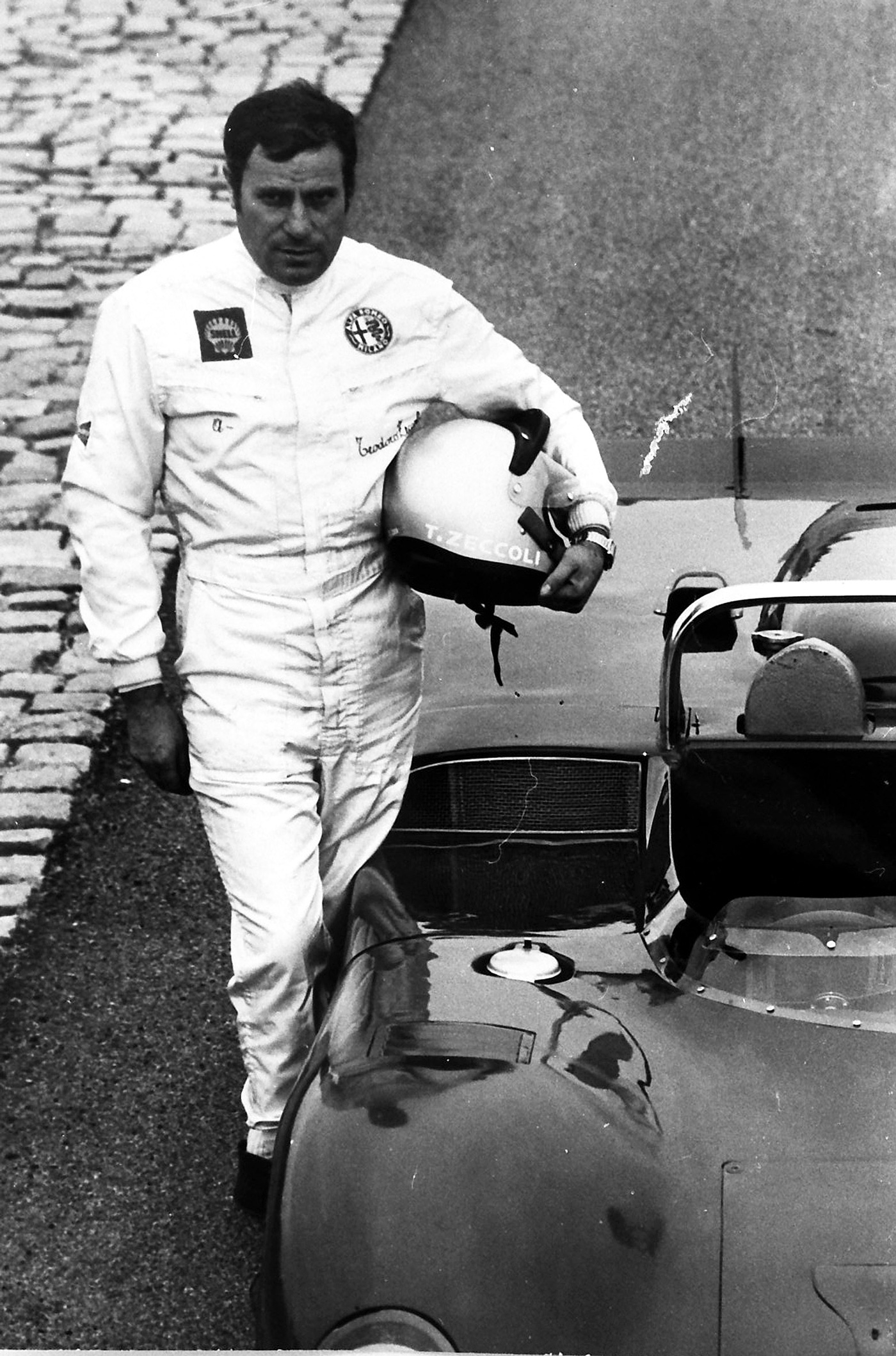
Zeccoli photographed posing with his helmet while testing the T33-3 in 1970 – the same helmet as in the color shot taken thirty years later in front of his dealership, below. (Photo credit Centro Documentazione Alfa Romeo, Arese, Zeccoli Archives)
Zeccoli had a twinkle in his eye as he recalls the moments in his racing career. He laughs as he recalls one of his most embarrassing moments when he put his factory Alfa Romeo TZ into the sandbanks at Mulsanne corner during the 1965 Le Mans race. He stripped off his racing suit and tried to dig himself out of the sand but it was hopeless. He was truly stuck and had to retire after two hours of racing and digging. Ironically, another of the Autodelta Alfas also retired on the second hour; this one driven by Carlo Zuccoli who, because of his similar name, was often confused with Zeccoli. When asked about the drivers he raced with he has no hesitation in picking out Englishman Piers Courage. ” To my mind, had he lived, he might have been one of the greatest drivers ever!”
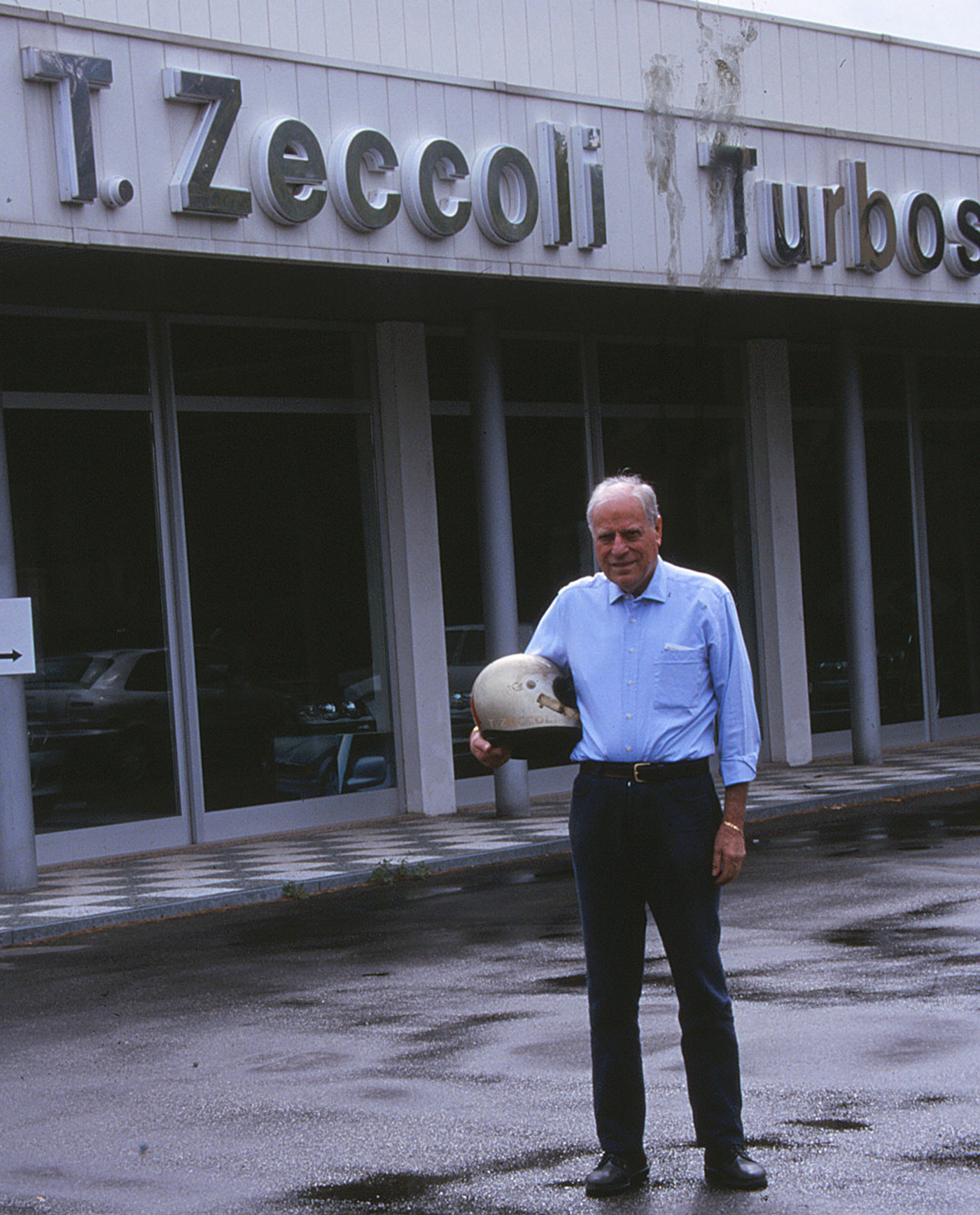
Teodoro Zeccoli in 2001 outside his BMW showroom and with his 1970 crash helmet. (Photo Graham Gauld)
Teodoro Zeccoli has no regrets in his life as a test driver. It brought with it a busy racing career driving a variety of cars. Unlike many drivers, he has kept every single memento of those years, including all his competition licences and even his crash helmets, which was why he was able to pose outside his dealership with the same helmet he used when photographed officially by Autodelta many years before. He is a happy man.
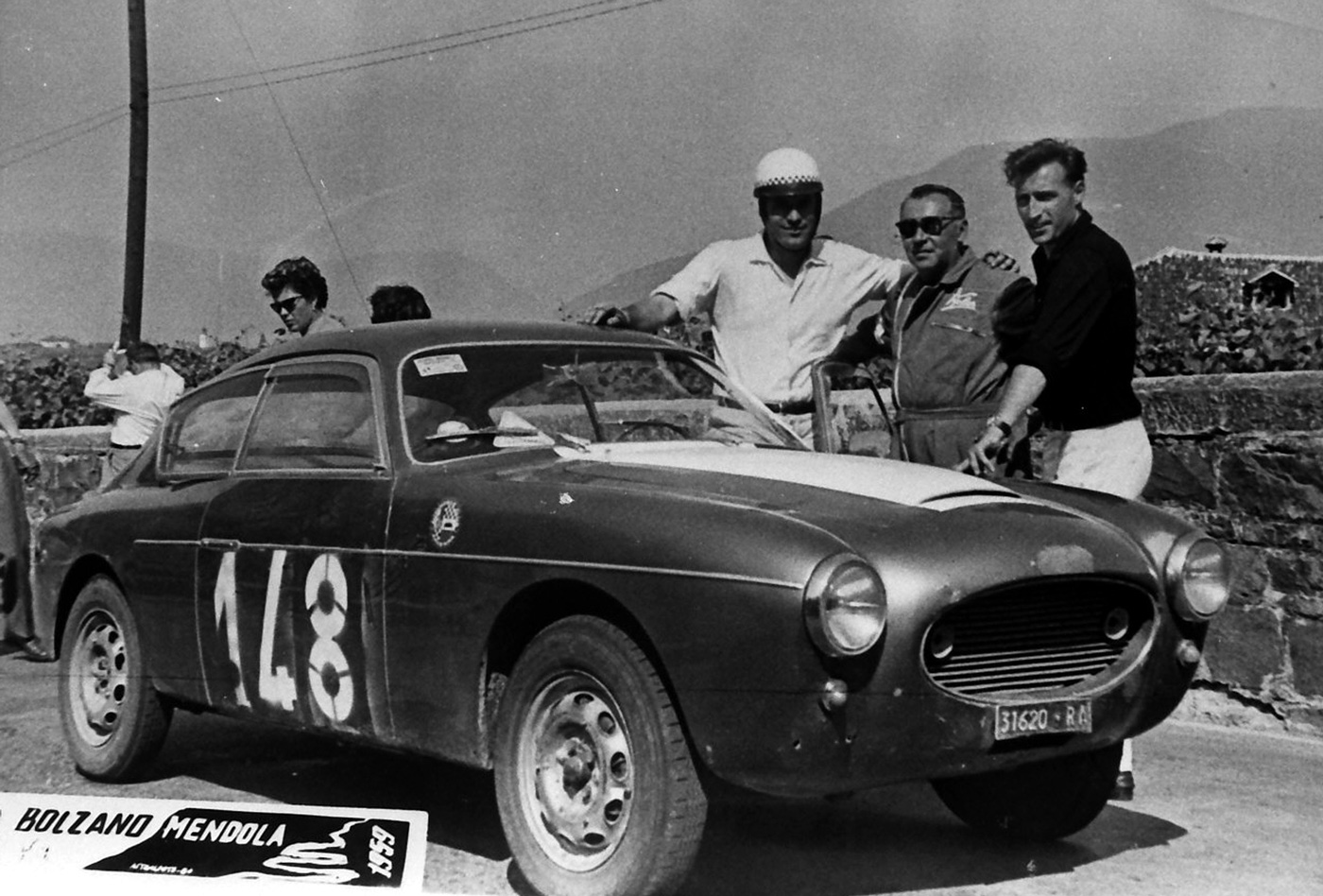
Wonderful man !